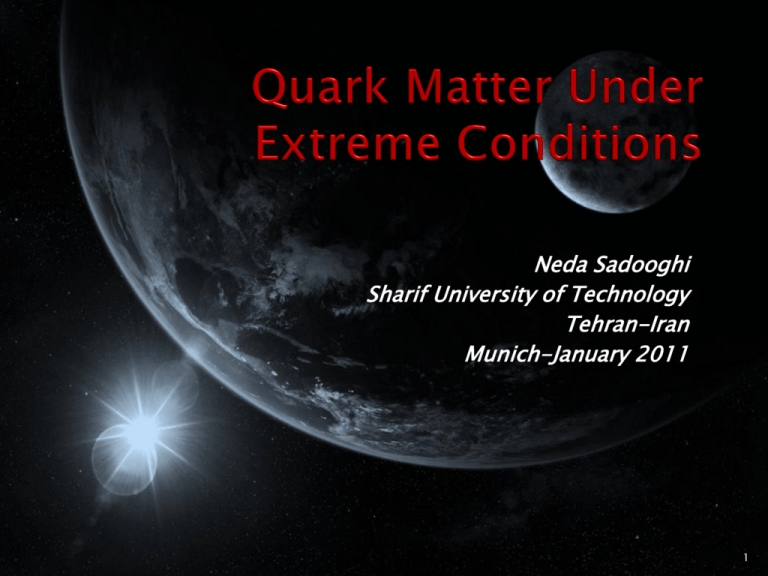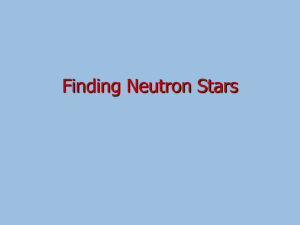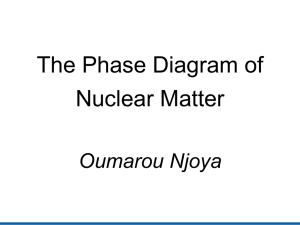Quark Matter Under Extreme Conditions
advertisement

Neda Sadooghi Sharif University of Technology Tehran-Iran Munich-January 2011 1 Strong nuclear force Force Electromagnetic force Strength Theory Mediator Strong 1of Everything Chromodynamics Gluon Theory Electromagnetic 10-2 Electrodynamics Photon Weak 10-7 Flavordynamics W+, W-, Z0 Gravitational 10-39 Geometrodynamics Graviton Weak nuclear force Gravitational force 2 1019 GeV 1014 GeV 100 GeV Inflationary Epoch Big Bang 100 MeV ~10-4 eV QCD Phase Transition QGP EW Phase Transition 3 Interaction Couples to Gauge Bosons Mass (GeV/c2) Strong Color charge Gluon 0 Electromagnetic Electric charge Photon 0 Weak Weak charge W+, W-, Z0 ~100 SU(3) x SU(2) x U(1) Fermions Leptons Quarks Family E- Charge 1 2 3 νe νμ ντ 0 e μ τ -1 u c t +2/3 d s b -1/3 Quark flavors Color - Weak Isospin LH RH 1/2 - Spin 1/2 0 r g b 1/2 0 1/2 0 Quark colors 4 Quantum Electrodynamics (QED) describes the force between electrically charged particles in terms of exchange of massless and neutral photons Elementary process (three point vertex): 5 Quantum Electrodynamics (QED) Coulomb Repulsion Coulomb Attraction 6 Quantum Chromodynamics (QCD) Elementary process(es) Gluons carry color-charge Gluon-Gluon Self-Interaction 7 Flux Lines Electric flux between a pair of Chromoelectric flux between equal and opposite charges Dipole field pattern a quark and an antiquark Flux tube 8 Quantum Chromodynamics (QCD) Static potential between a quark-antiquark pair A(r ) V (r ) r r A(r ) 1 ln r r 0 ↷ A(r) 0 ↷ V(r) 0 Asymptotic Freedom ~ 880 MeV / fm 9 String Tension σ~ 880 MeV/fm A force sufficient to lift three elephants !!! 10 Confining Potential Color Confinement Hadrons are color singlet 11 Helicity: For massless particles, helicity and chirality are the same Right handed particles have positive helicity (chirality) Left handed particles have negative helicity (chirality) Up and down quarks can be regarded as massless A theory including only up and down quarks should be symmetric under global chiral transformation 12 13 The mysteries of Mexican Hat Potential Spontaneous Chiral Symmetry Breaking: (Pseudo) Goldstone Mechanism: SUL(2) x SUR(2) SUL+R(2) π+ π0 π- 100 MeV QCD Phase Transition Big Bang QGP 15 QCD phase transition at TQCD~2.4 x1012 K~ 200 MeV Core of our Sun ~ 1.57 x 107 K ~1.3 keV Room temperature ~ 27 C ~ 300 K ~ 25 meV 16 N d d u LHC s RHIC Early Universe Temperature QCD Phase Diagram u ConfinementChiral Deconfinement Symmetry phase Restoration Hadronic Fluid transition u u Hadronic Phase Hadron gas s s s Quark Gluon Plasma Phase SPS Tc~170 MeV d Nuclear Matter μc~310 MeV d d s d u u s s d u u CFL 2SC s Color phase d Superconducting Neutron Stars Baryonic Chemical Potential 17 Neutron stars: Laboratories of Matter under Extreme Conditions 18 Natural laboratory for extreme conditions Neutron star is a type of stellar remnant that can result from gravitational collapse of a massive star during a supernova event When a giant star dies, it can collapse into a black hole or implode into an ultra-dense neutron star Pauli exclusion principle supports the neutron star against further collapse (they are made almost entirely of neutrons) 19 Neutron star radius: 12 km 0.3-0.4 ϱ0 0.5-2.0 ϱ0 >2ϱ0 Outer crust 0.3-0.5 km Ions and electrons Inner crust 1-2 km Electrons, neutrons, nuclei Outer core ~9 km Neutron-proton Fermi liquid Few % electron Fermi gas Inner core 0.3 km Quark-Gluon Plasma/ CFL Color Superconductor ??? 20 Radius 6.4x103 km ~6.96 x105 km 12 km 108 x Earth Mass 6x1024 kg 2x1030 kg ~3x106 x Earth 2.4x 1030 kg 1.2-2 Solar mass Density 5 g/cm3 (Mean density) 162.2 g/cm3 (Core) 2.7 x1014 g/cm3 (Core) Surface gravity g ~28 g 7x1011 g Escape velocity 11 km/s 617.7 km/s 1.3x105 km/s 56 x Earth 1/3 c 1.57 x 107 K 1011 K~ 1-10 MeV Temperature (Core) 5700 K ~104 Solar T 21 Neutron Stars 5.5 10 kg 900 12 22 Pulsars are highly magnetized, rotating neutron stars that emit a beam of electromagnetic radiation Because neutron stars are very dense objects, the rotation period and thus the interval between observed pulses is very regular Atomic Clocks The observed periods of the pulses range from 1.4 msec to 8.5 sec Extremely large magnetic fields Magnetars Surface: B~1014-1015 G Inner field: B~1018-1020 G 23 Extreme Magnetism The Earth’s B field Measured at the magnetic pole 0.6 G Hand-held magnet Like those used to stick papers on a refrigerator 100 G Within dark, magnetized areas on the solar surface 4000 G The strongest, sustained magnetic fields achieved in the lab Generated by huge electromagnets 4.5 X 105 G ~ 45 T The strongest fields ever detected on non-neutron stars Strongly-magnetized, compact white dwarf stars The magnetic field in strong sunspots Typical surface magnetic fields of radio pulsars Magnetars: Inner fields The most familiar kind of neutron star Soft gamma repeaters and anomalous X-ray pulsars 108 G 1014-1015 G 1018-1020 G 24 Vacuum Birefringence (double refraction) Polarized lightSome waves change speed Calcite crystal: letters showing the and hence wavelength when they enter a very strong magnetic double refraction field Liquid Crystal Displays are also birefringent Photon Splitting X-rays split in two or merge together. This process is important in fields stronger than 1014 G Scattering Suppression A light wave can glide past an electron with little hindrance if the field is large enough to prevent the electron from vibrating with the wave Distortion of Atoms Fields above 109 G squeeze electron orbitals into cigar shapes. In a 1014 G field, a hydrogen atom become 200 times narrower 25 RHIC LHC N Early Universe Temperature Effects of Extreme Magnetism on Quark Matter Quark Gluon Plasma Phase Tc~170 MeV Hadronic Phase Chiral-SB phase Color Superconducting phase Neutron Stars Baryonic Chemical Potential 26 27 Center of mass energy √s=200 AGeV for Au+Au collision Collision with 99.7% speed of light Ultra-RHIC The energy density ε= 5.5 GeV/fm3 The pressure generated at the time of impact 1030 atmospheric pressure 28 Question: Deconfinement Phase Transition 29 ? ? Color Glass Condensate (CGC) sheets CGC Initial singularity at the time of collision Glasma phase (Out of Equilibrium Physics) Not expected: Strongly correlated QGP (Perfect Fluid) Initial Singularity Glasma Mixed phase (quarks, gluons and hadrons) sQGP Hadron Gas Hadron Gas 30 The evolution of matter produced in the Little Bang is comparable with the Big Bang (same evolution equations) t=10-21-10-20sec t=10-22-10-21sec t=0-10-22sec Perfect Liquid: Strongly Correlated QGP Idea supported by the conjecture of AdS/CFT duality T Magnetized Plasma e-strongly correlated Tc Electric Plasma m- strongly correlated ?? T~ 2 Tc Deconfinement sQGP Confinement Dual superconductivity m-correlation e-confined CS (Color) Superconductivity e-correlation m-confined ?? 1101.1120 Shifman et al μB 32 Chiral Magnetic Effect Parity Violation in QCD Strong CP Problem Question: Is the world distinguishable from its mirror image? Answer(s): Weak interaction violates P and CP Strong interaction: C: Matter↔Antimatter P: Mirror symmetry Experimentally: Neutron’s EDM ~No 0 evidence of global strong CP violation Theoretically: QCD θ ≠ 0 ( topological charge) Thebound existence topological charge CP problem Experimental for of θ< 3x10-10 Strong Matter-Antimatter asymmetry in the Early Universe !! 33 Chiral Magnetic Effect Local (event by event) P and CP Violation in QCD Theory: Fukushima, (2007-09) Charge separation stemsKharzeev, from theWarringa, interpaly McLerran, between the strong magnetic field in the early stage of heavy ion collision and the Lattice: Polikarpov et al. (2009-10) presence of topological configurations in hot matter → → B~L Charge separation Electric current QGP in the deconfined phase J~B 34 Chiral Magnetic Effect Local Parity Violation in QCD Chiral magnetic Effect B p uL dR dR uR Charge Separation dR J~B L uR dL R uR 0 35 Chiral Magnetic Effect RHIC √sNN ~ 200 GeV b~4 fm eB ~1.3 mπ2 ↷ B ~ 4x1018 G Very Strong Magnetic Field Non-Central HIC 1019 Gauss √sNN ~ 200 GeV LHC Non-Central HIC √sNN ~ 4.5 TeV eB (MeV2) RHIC Non-Central HIC b~4 fm b~4 fm eB ~1.3 mπ2 ↷ B~ 4x1018 G eB ~15 mπ2 ↷ B~ 5x1019 G 1014 Gauss D.E.of Kharzeev, L.D. McLerran, H.J. Warringa (0711.0950) The strength B is comparable withand Magnetic Field in Neutron Stars 36 RHIC N LHC Temperature Effect of Strong Magnetic Fields on Color Superconductivity Quark Gluon Plasma Phase Tc~170 MeV Hadronic Phase Chiral-SB phase Color Superconducting phase Neutron Stars Baryonic Chemical Potential 37 Effect of Strong Magnetic Fields on Color Superconductivity QED Superconductivity vs. Color Superconductivity Ingredients: (QED) A liquid of fermions with electric charge (QCD) Quarks with electric and color charges q q (QED) An attractive electromagnetic interaction between the fermions (QCD) An attractive strong interaction between two quarks (QED) Low temperature: T<Tc (QCD) Low temperature: In neutron stars T<100 MeV ≪ Big Bang T~1019GeV Results: (QED) QED Meissner Effect Photons acquire mass (QCD) QCD Meissner Effect Gluons acquire mass 38 Effect of Strong Magnetic Fields on Color Superconductivity Effects on QCD Phase Diagram (I): Sh. Fayazbakhsh and NS: PRD (2010) Normal ChSB ChSB CSC ChSB CSC Normal CSC Normal Normal ChSB Normal ChSB ChSB 39 Effect of Strong Magnetic Fields on Color Superconductivity Effects on QCD Phase Diagram (II): Low μ: Only chiral phase transion De Haas-van oscillations Alphen before the system enters the regime of LLL dominance 2nd order phase transition from chiral SB to the Normal phase 40 Effect of Strong Magnetic Fields on Color Superconductivity Effects on QCD Phase Diagram (III): Low T: Chiral and Color phase transions 41 Results 1. The type of the phase transition between chiral SB and the Normal phase changes with B: 2nd Order 1st Order 2. Increasing B has no effect on the type of phase transition between the color symmetry breaking and the normal phase (2nd order) 3. De Haas-Van Alphen oscillations CSC-Normal-CSC phase transition 5. For eB>eBt ~ 0.5 GeV2: System is in the LLL dominant regime 4. For eB>eBt: The effect of T and μ are partly compensated by B 42 43 Effect of Strong Magnetic Fields on Color Superconductivity Effects on QCD Phase Diagram (II): Intermediate μ: Chiral and Color phase transions 44 Effect of Strong Magnetic Fields on Color Superconductivity Effects on QCD Phase Diagram (II): Large μ: Only Color phase transion 45 Effect of Strong Magnetic Fields on Color Superconductivity Effects on QCD Phase Diagram (III): Intermediate T: Chiral and Color phase transions 46 Effect of Strong Magnetic Fields on Color Superconductivity Effects on QCD Phase Diagram (III): Large T: Only Chiral phase transion 47




